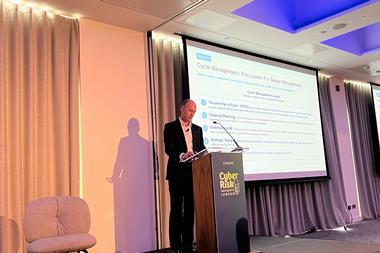Replacing your legacy software can offer flexibility, greater efficiency, and even save money
Let’s say you’re an insurer with a customer who’s a City worker. The customer gets into a car accident and is uninjured, but the car isn’t so lucky. So you offer them a hire car, right?
Not necessarily.
Considering the claimant works in the City (and most likely won’t need their car during the week), they’d probably prefer to have their no-claims bonus protected instead. This option would cost the insurer less than a hire car, so it’s a better option for both sides.
But in order to make such a decision, an insurer would obviously need to know that the policyholder works in the City. And that, says Graham Jackson, IBM Global Business Services’ associate partner for insurance, is the challenge.
“This would fall broadly under predictive analytics,” he says. “But the challenge is that analytics models are really static: you do some analysis and work out the relationships between the data and then present that as a business [claims system] rule, which might get updated every six months.
“But customer behaviour changes quickly. So what you really want is something that continually learns from all the transactions that happen across the organisation.” So what to do?
Claims IT has been undergoing a revolution over the past couple of years. Legacy systems basically mimicked a paper-based process; that is, basic data was recorded but not fused with information from third parties or with information on customer behaviour.
Now, insurers have the ability to share customer information across the insurance company, as well as with third parties. But many insurers still haven’t moved off their legacy systems, which is something that software vendors are scrambling to change.
There has been a migration within the vendors’ offerings towards “open architecture”, which is a claims system that allows components to be added, upgraded or swapped. These platforms are also moving to “service-oriented” architecture, which means they are flexible and can link with systems from third parties. Greater exchange of data enables an insurer to better understand and handle what a customer might want or need when making a claim.
“Customers want to deal with insurers in a different way,” IBM’s Jackson says. “Insurers need to be able to accommodate that, so there’s a lot more pressure to know your customer – not just in a claims context, but to know their value across the organisation.
“Decisions about claims ought to be made in the context of knowing the value of that customer to the whole organisation,” he adds. “So there’s a lot of interest in developing a single customer view [only one record of that customer] across all the applications and propositions that an insurer offers, and continuously recording the interactions between the customer and insurer.”
Legacy systems
Even though new technology like this is available, too many insurers are still using outdated systems, according to a report published in September by Gartner. It states: “Few European general insurers are buying new claims administration solutions. Most use monolithic systems that couple claims with policy, underwriting and billing functionality, and they find it difficult to build a business case for complete system replacement.”
The report recommends that insurers consider newer packaged offerings rather than building new claims administration solutions in-house. “Look for established vendors or those with flexible, rule-driven solutions that you can configure to meet your company needs and country-specific requirements.”
IBM’s Jackson comments: “The challenge from an insurer perspective is: can they set a technology bar, around which supply chains can work with them? You see the large players who have a really strong capability of integrating supply chains; they would not consider a supplier unless they were a unique supplier or met certain IT criteria.”
Beyond the basics
Guidewire is an example of a core systems vendor that offers end-to-end claims management, from first notice of loss through to policy administration. But it also has the flexibility to link to other systems, such as document management and accounts payable systems.
Guidewire’s European product marketing director, Katie Doyle, says: “Having systems that facilitate integration with others in the IT landscape is really critical, because every insurer out there is going to have many systems of many different vintages and built on many different platforms.”
She adds: “It’s also critical to have a platform that allows [insurers] to modify their business processes as their business or the market changes. Legacy systems are very brittle and expensive to modify. But modern systems like ours, which are based on business rules, are more flexible.”
Meanwhile, insurers are also developing portals where customers can log on and get a tailored view of their claim status; especially important considering Jackson believes that around 8% of an insurer’s total claims costs come from claims staff answering questions about the status of a claim.
Audatex is an example of this type of data exchange. It has a web-based claims tracking system that relays data between body shops, claims handlers and policyholders. It tracks vehicle progression throughout the claim.
Other vendors can also use data from Audatex. For example, financial IT?provider SSP can interface with web services like Audatex, then transfer that data through to an insurer as an extension of its core claims system offering.
SSP’s Andy Nightingale, who is head of strategy and propositions within the insurer division, says: “Many insurers are challenged with their existing legacy system in being able to utilise it to bring that rich and efficient service to their customers. [SSP platform] Insure J, for example, can bring together all of these distributed technology messages and turn them into a very high-value service.”
Going by the book
Insurers have certain rules that dictate how they run their business, which are called business rules. These rules can be put into a software system that ensures these rules are followed.
One example of where business rules might apply in a claims system is fraud. Systems can be set up to deliver “fraud scoring”. If a set of questions is answered in a certain way, this would trigger the system to “red flag” a claimant. At this point, the insurer might refer the claim to a special investigation unit as a result of the data they captured.
“The packages have historically had a rudimentary business rule capability – a validation of data quality,” Jackson says. “But what I see more and more is the complexity of those rules increasing.”
He adds: “As the complexity and intelligence around this has increased … specialist rules engines are being invoked and interface as a component within the insurance claim. We see very prescriptive rules about what a claims handler has to do.”
So what next?
The benefits of using a software platform that will integrate all the various strands of information, and enable more efficient claims management, are clear. But where to start? First thing’s first: consider your legacy core system and what you need to do in order to get your foundation right. Is your current system adequate for your current – and future – business requirements? If not, consider the option of replacing rather than adding onto your existing set-up. See the box, above, for the key points to consider.
Instead of one large core system, the trend is now for insurers to use products from a number of different providers. As a result, claims systems need to be flexible and able to link to others. This might seem like an added layer of complexity, but in reality it’s about freedom and the ability to choose the best solution for your business from a range of different providers, and help you provide best-of-breed customer service. IT
Postscript
Before you buy a new claims system:
- Realistically assess whether your current claims administration system can meet your current and future business needs.
- Evaluate packaged offerings instead of building new claims administration solutions in-house.
- In most cases, this will be faster, less costly and more effective.
- Consider what countries you want your systems supported in, as there are different regulatory requirements.
- Make sure the vendor will provide adequate professional services assistance in your area.






































No comments yet